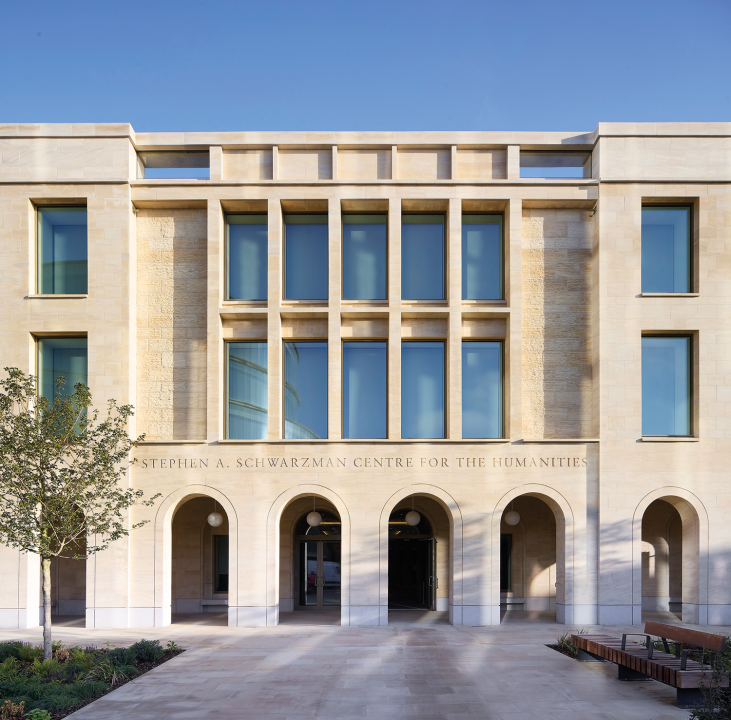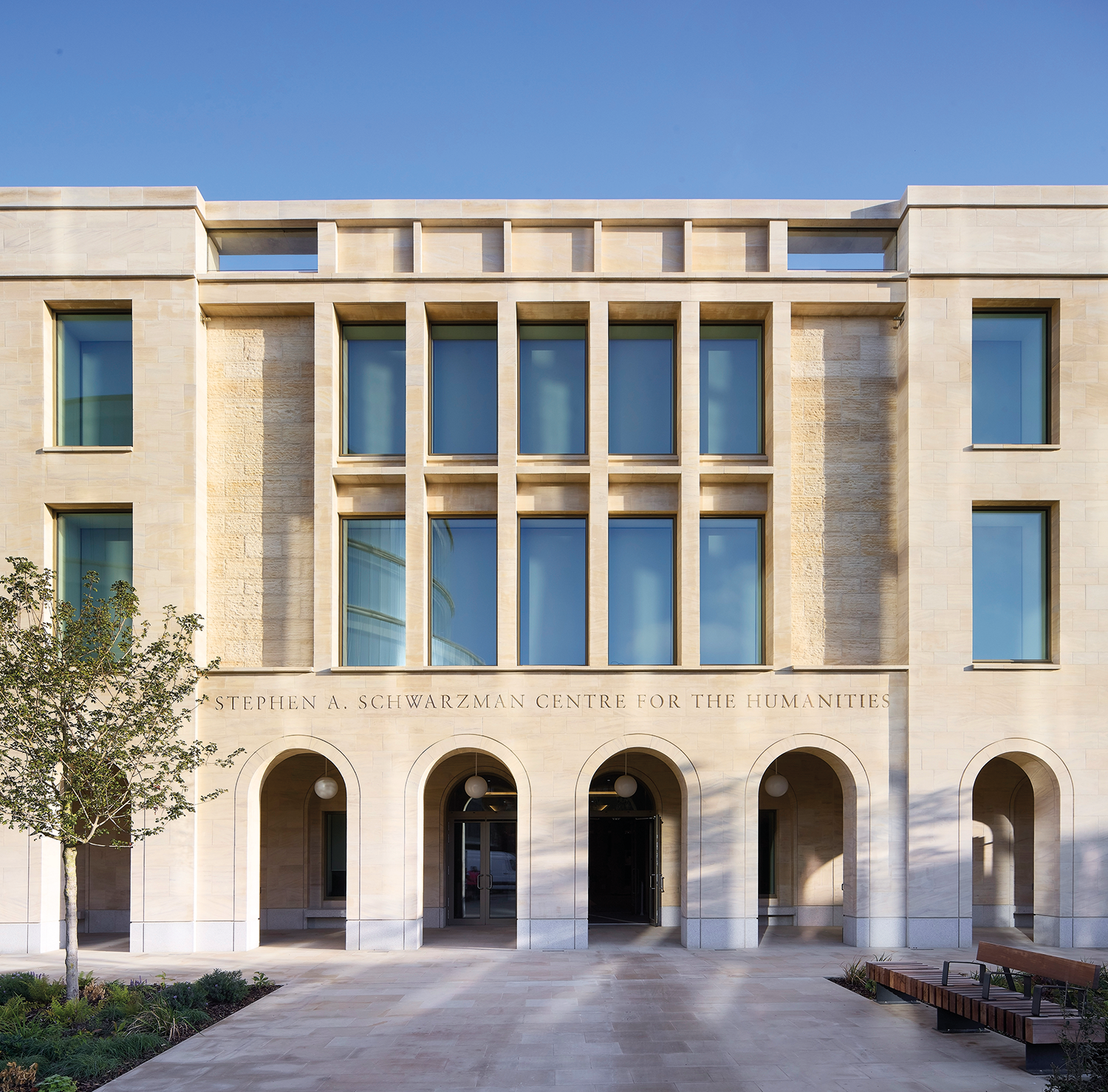
It is very hard to imagine the University of Oxford ever constructing a modernist building again. This is the significance of the new Schwarzman Centre for the Humanities. In its sheer scale, in its prominence both within the city centre and within the university – the first multi-department, purpose-built structure to open in its history – it is the most important building to be erected in Oxford in half a century and an endstop to an architectural era. One can imagine that its use of a restrained classicism won’t just influence the architectural aesthetics of Oxford but also of other universities within historical cities, both in the UK and internationally.
Its impact is all the more profound given its radical – in Oxford terms – proposition. Since that unfortunate incident in 1209 when Oxford’s townspeople lynched a student, prompting some scholars to flee to Cambridge where they founded an alternative place of study, the university has developed a built form to keep the city at arm’s length. The beautiful cloistered quadrangles that we know today are legible as such only from the inside. They are walls to those who live outside them. This typology has evolved but remained largely unchanged even into the 20th century.
This is despite the fact that one of the propositions of modernism in postwar Britain was to be somehow open, either visually through glazed façades or through huge open plans once inside. This has not been the case in Oxford, where the impact of modernism has been largely symbolic. The exoskeleton of the Thomas White Building at St John’s College by Arup Associates may straddle the old wall on Lamb and Flag Passage but it remains inaccessible except to those who are allowed through the porters’ gate. The Schwarzman is a genuine attempt to reorder that relationship with an open-access building – the public is free to wander both the ground floor and basement.
One of the achievements of the postwar modernists, however, was their ability to create megastructures that blended multiple uses – Denys Lasdun’s University of East Anglia complex comes to mind. At the Schwarzman Centre, the marriage of so many departments is reconciled around a central route at ground-floor level between two formal north and south façades, all clad in the Clipsham stone that was introduced into Oxford in the 1870s and has since gradually replaced the local stone.
At its centre is a three-storeys high, oak-lined space with entries to key departments at cardinal points. Rather than sacrificing the symmetry and coherence of this atrium, the reconciliation of the different needs of departments happens away from view. Meanwhile, the toing and froing of 600 academics and their students to seven different departments – including English, history and philosophy – takes place beneath an oak crown that shades the building’s dome: a compelling image of tradition and modernity in harmony. The really complicated work is in the basement, with its jaw-dropping, 500-seat, wood-and-concrete concert hall, a brilliant little 250-seat theatre, and several other performance spaces.
It is said that the classicism of the centre is largely down to the taste of the donor, which perhaps says something about the strength or otherwise of the planning committees in the city. However they have got lucky. Stephen Schwarzman is the co-founder of equity firm Blackstone and a Republican super-donor, with an off-on friendship with Trump and an MBA from Harvard Business School. If his £185 million gift to Oxford seems strange – he’s not a Rhodes scholar – that is to judge him by the generally self-serving culture of US philanthropy. Fortunately Schwarzman has a sense of the civic values of universities and a very clear architectural agenda.
The buildings appear motivated by a belief in classical architecture as a vehicle for civic principles
Following the incredible growth of Blackstone in 2013, he created a Rhodes-style programme for US students at Tsinghua University in Beijing and through that founded a key relationship with the American architect Robert A.M. Stern. The Beijing Schwarzman is clad in the grey brick characteristic of the city and uses its typologies to create strong shared spaces. Beyond a low garden wall with open-entrance pavilions is a courtyard, around which is a double-height forum. The big conference space is beneath the courtyard, not unlike the Oxford Schwarzman. Above, the scholars live in single rooms around common lounges. Stone and brick panels surround large windows, all beneath a traditional tile roof. Classical but with Chinese characteristics.
Stern – his playful postmodernist period of the 1980s well and truly behind him – was also the architect of the classical extension to the Harvard Law School in 2012, not funded by Schwarzman but clearly something that the donor, and Hopkins, the architects of the Centre for the Humanities, have looked at. The variegated limestone façades and arched entrance porches of the building in Cambridge, Mass., are more portentous than the refined Georgian scale of the Oxford porticos but we are, as they say, in the same ballpark. In the buildings that Schwarzman has funded, there are a coherent set of ideas: they are impressively democratic in intention, if not in practice, and appear motivated by a belief in classical architecture as a vehicle for civic principles.
For the Schwarzman Centre at Yale, Stern renovated the 1901 Commons building by Carrère and Hastings together with three floors of the adjoining Memorial Rotunda. Perhaps this was where the Oxford building was born. Like at Oxford, the Commons offers a large, central space with simple architectural gestures: in Yale’s case, a dining room with brick pilasters that lead the eye up to ornate roof trusses. From plain brick and wood, something of great grandeur is made.
Oxford has had modern classical architecture before of course. Robert Adam produced the Art, Archaeology and Ancient World Library, half a mile away from the Schwarzman in 2001. Adam’s building is admittedly less classicist and more postmodern than perhaps was intended. The drum of the library is a cramped melancholy echo of the baroque Radcliffe Camera to which all circular forms in Oxford make obeisance. (Indeed the central spine of the Schwarzman is similar to the plan of the Camera and its environs, albeit as a domed interior.) Adam’s later Levine Building at Trinity College was disappointingly bland: a Mittel-European courtyard building.
But the Schwarzman supersedes the style wars – the late 20th-/early 21st-century jousting match between the trads (of which Adam is one) and the moderns. Andrew Barnett at Hopkins Architects may claim his building is contextual; it does share something with the Oxford University Press building on nearby Great Clarendon Street: a grand entrance with plane wings, stone-fronted, brick-flanked. However the Centre’s closest neighbour is the futurist glazed disks of the Blavatnik School of Government (2012) by Herzog de Meuron. The Schwarzman is a riposte to that building, a clarification of the organisational principles of late 20th-century megastructures. It offers a symmetrical building, with a central entrance route through two arched classical porticos clad in stone. A palpably traditional civic institution.
It is a long time since a modernist building has had a similar impact; the University Campus UTEC in Lima (2015) by the Irish practice Grafton Architects springs to mind. In Oxford, this architectural movement has only left a handful of striking examples: the Denys Wilkinson Building, built to house the Van de Graaf generator, and James Stirling’s cramped, mildew-infested Florey Building. (The fractious build of the Florey and the flaws in its construction put the university off building anything in any style for most of the 1970s and 1980s, and led to senior academics at Oxford writing to colleagues advising them to blacklist its architect.) The Blavatnik arrived as a strange, almost primitivist end point to all this, with perhaps Powell & Moya’s overlooked Wolfson College presenting the only compelling vision of education’s task in modernist form.
Of course there is a certain irony that the rather flat façade of the Schwarzman was made in a factory near Worksop: prefabrication being one of modernism’s key innovations. And yes, the ominously named and factory-like Life and Mind Building – which will house the departments of experimental psychology and biology – creeps towards conclusion, much of its massive bulk hidden away at the eastern flank of the city centre. The Schwarzman, though, shows that the energy and the money is with the classical.









Comments